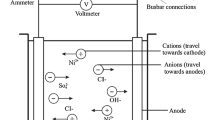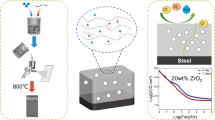This study is an attempt of applying new electrolytes to obtain a new generation of oxide coatings. An oxide coating was deposited on Al(Al 99.5) aluminum. The influence of an organic additive and anodizing parameters on the nanomorphology and nanostructure of the obtained coatings is described. The nanostructure and nanomorphology of oxide coatings are determined using a scanning electron microscope (SEM). An attempt is made to apply a new oxide coating for the sliding interaction with TGK 20/5 material. The tests were carried out under the conditions of dry friction. The friction coefficient is found for the investigated sliding couple, as well as the intensity of wear of specimens made of this material. The influence of the nanostructure of oxide coating on the tribological properties of the tested couple is also determined.








Similar content being viewed by others
References
W. Skoneczny, Shaping the Properties of Aluminum and Aluminum Alloys’ Upper Layers by the Hard Anodizing Method, Łódź University of Technology, Bielsko-Biała (2001).
S. Pytko, “The directions of tribology development in the world,” in: Conf. on New Trends in Tribology and Tribotechnology, Częstochowa (1997), pp. 5–14 .
B. Ciszewski and W. Przetakiewicz, Modern Materials in Technology, Bellona Publishing House, Warsaw (1993).
M. M. Student, V. М. Dovhunyk, and М. D. Klapkiv, “Tribological properties of combined metal-oxide–ceramic layers on light alloys,” Mater. Sci., 48, No. 2, 180–191 (2012).
W. Skoneczny, “Model of structure of Al2O3 layer obtained via hard anodizing method,” Surface Eng., 17, 389–392 (2001).
W. Skoneczny, “Analysis of morphology and microstructure Al2O3 layers,” Mater. Sci., 46, No. 2, 276–282 (2010).
W. Skoneczny, J. Jurusik, and A. Burian, “Investigations of the surface morphology of Al2O3 layers by atomic force microscopy,” Mater. Sci. (Poland), 3, 265–278 (2004).
T. Kmita, J. Szade, and W. Skoneczny, “Gradient oxide layers with an increased carbon content on an AW-5251 alloy,” Chem. Process Eng., 29, 375–387 (2008).
M. Bara, W. Skoneczny, and M. Hajduga, “Ceramic-graphite surface layers obtained by the duplex method on an aluminum alloy substrate,” Chem. Process Eng., 30, 431–442 (2009).
T. Kmita and W. Skoneczny, “Gradient layers on aluminum alloys created electrolytically method,” Chem. Process Eng., 26, 735–744 (2005).
Author information
Authors and Affiliations
Corresponding author
Additional information
Published in Fizyko-Khimichna Mekhanika Materialiv, Vol. 50, No. 3, pp. 111–116, May–June, 2014.
Rights and permissions
About this article
Cite this article
Skoneczny, W. Influence of the Nanostructure of Surface Ceramic Coatings on Their Tribological Properties. Mater Sci 50, 435–442 (2014). https://doi.org/10.1007/s11003-014-9739-y
Received:
Published:
Issue Date:
DOI: https://doi.org/10.1007/s11003-014-9739-y




